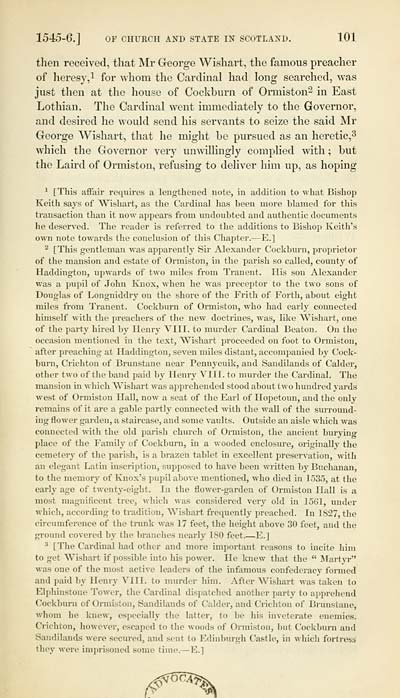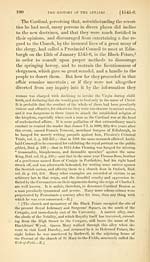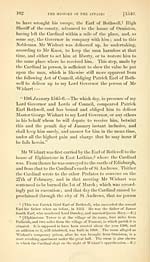Spottiswoode Society > History of the affairs of the Church and State of Scotland from the beginning of the reformation to the year 1568 > Volume 1
(237) Page 101
Download files
Complete book:
Individual page:
Thumbnail gallery: Grid view | List view

1545-6.] OF CHURCH AND STATE IN SCOTLAND. 101
then received, that Mr George Wishart, the famous preacher
of heresy, 1 for whom the Cardinal had long searched, was
just then at the house of Cockburn of Ormiston 2 in East
Lothian. The Cardinal went immediately to the Governor,
and desired he would send his servants to seize the said Mr
George Wishart, that he might be pursued as an heretic, 3
which the Governor very unwillingly complied with ; but
the Laird of Ormiston, refusing to deliver him up, as hoping
1 [This affair requires a lengthened note, in addition to what Bishojj
Keith says of Wishart, as the Cardinal has been more blamed for this
transaction than it now appears from undoubted and authentic documents
lie deserved. The reader is referred to the additions to Bishop Keith's
own note towards the conclusion of this Chapter. — E.]
3 [This gentleman was apparently Sir Alexander Cockburn, proprietor
of the mansion and estate of Ormiston, in the parish so called, county of
Haddington, upwards of two miles from Tranent. His sou Alexander
was a pupil of John Knox, when he was preceptor to the two sons of
Douglas of Longniddry on the shore of the Frith of Forth, about eight
miles from Tranent. Cockburn of Ormiston, who had early coimected
himself with the preachers of the new doctrines, was, like Wishart, one
of the party hired by Henry VIII. to murder Cardinal Beaton. On the
occasion mentioned in the text, Wishart proceeded ou foot to Ormiston,
after preaching at Haddington, seven miles distant, accompanied by Cock-
burn, Crichton of Brunstane near Pennycuik, and Sandilauds of Calder,
other two of the band paid by Henry VIII. to murder the Cardinal. The
mansion in which Wishart was apprehended stood about two hundred yards
west of Ormiston Hall, now a seat of the Earl of Ilopetoun, and the only
remains of it are a gable partly connected with the wall of the surround-
ing flower garden, a staircase, and some vaults. Outside an aisle which was
connected with the old parish church of Ormiston, the ancient burying
place of the Family of Cockburn, iu a wooded enclosure, originally the
cemetery of the parish, is a brazen tablet in excellent preservation, with
an elegant Latin inscription, supposed to have been written by Buchanan,
to the memory of Knox's pupil above mentioned, who died in 1535, at the
early age of twenty-eight. In the flower-garden of Ormiston Hall is a
most magnificent tree, which was considered very old in 1561, under
which, according to tradition, Wishart frequently preached. In 1827, the
circumference of the trunk was 17 feet, the height above 30 feet, and the
ground covered by the branches nearly 180 feet. — E.]
3 [The Cardinal had other and more important reasons to incite him
to get Wishart if possible into his power. He knew that the " Martyr"
was one of the most active leaders of the infamous confederacy formed
and paid by Henry VIII. to murder him. After Wishart was taken to
Elphiustone Tower, the Cardinal dispatched another party to apprehend
Cockburn of Ormiston, Sandilauds of Calder, and Crichton of Brunstane,
whom he knew, especially the latter, to be his inveterate enemies.
Crichton, however, escaped to the woods of Ormiston, but Cockburn and
Sandilands were secured, and sent to Edinburgh Castle, in which fortress
they were imprisoned some time. — E.]
^^
then received, that Mr George Wishart, the famous preacher
of heresy, 1 for whom the Cardinal had long searched, was
just then at the house of Cockburn of Ormiston 2 in East
Lothian. The Cardinal went immediately to the Governor,
and desired he would send his servants to seize the said Mr
George Wishart, that he might be pursued as an heretic, 3
which the Governor very unwillingly complied with ; but
the Laird of Ormiston, refusing to deliver him up, as hoping
1 [This affair requires a lengthened note, in addition to what Bishojj
Keith says of Wishart, as the Cardinal has been more blamed for this
transaction than it now appears from undoubted and authentic documents
lie deserved. The reader is referred to the additions to Bishop Keith's
own note towards the conclusion of this Chapter. — E.]
3 [This gentleman was apparently Sir Alexander Cockburn, proprietor
of the mansion and estate of Ormiston, in the parish so called, county of
Haddington, upwards of two miles from Tranent. His sou Alexander
was a pupil of John Knox, when he was preceptor to the two sons of
Douglas of Longniddry on the shore of the Frith of Forth, about eight
miles from Tranent. Cockburn of Ormiston, who had early coimected
himself with the preachers of the new doctrines, was, like Wishart, one
of the party hired by Henry VIII. to murder Cardinal Beaton. On the
occasion mentioned in the text, Wishart proceeded ou foot to Ormiston,
after preaching at Haddington, seven miles distant, accompanied by Cock-
burn, Crichton of Brunstane near Pennycuik, and Sandilauds of Calder,
other two of the band paid by Henry VIII. to murder the Cardinal. The
mansion in which Wishart was apprehended stood about two hundred yards
west of Ormiston Hall, now a seat of the Earl of Ilopetoun, and the only
remains of it are a gable partly connected with the wall of the surround-
ing flower garden, a staircase, and some vaults. Outside an aisle which was
connected with the old parish church of Ormiston, the ancient burying
place of the Family of Cockburn, iu a wooded enclosure, originally the
cemetery of the parish, is a brazen tablet in excellent preservation, with
an elegant Latin inscription, supposed to have been written by Buchanan,
to the memory of Knox's pupil above mentioned, who died in 1535, at the
early age of twenty-eight. In the flower-garden of Ormiston Hall is a
most magnificent tree, which was considered very old in 1561, under
which, according to tradition, Wishart frequently preached. In 1827, the
circumference of the trunk was 17 feet, the height above 30 feet, and the
ground covered by the branches nearly 180 feet. — E.]
3 [The Cardinal had other and more important reasons to incite him
to get Wishart if possible into his power. He knew that the " Martyr"
was one of the most active leaders of the infamous confederacy formed
and paid by Henry VIII. to murder him. After Wishart was taken to
Elphiustone Tower, the Cardinal dispatched another party to apprehend
Cockburn of Ormiston, Sandilauds of Calder, and Crichton of Brunstane,
whom he knew, especially the latter, to be his inveterate enemies.
Crichton, however, escaped to the woods of Ormiston, but Cockburn and
Sandilands were secured, and sent to Edinburgh Castle, in which fortress
they were imprisoned some time. — E.]
^^
Set display mode to: Large image | Transcription
Images and transcriptions on this page, including medium image downloads, may be used under the Creative Commons Attribution 4.0 International Licence unless otherwise stated. ![]()
| Permanent URL | https://digital.nls.uk/79599632 |
|---|
| Description | Volume I. |
|---|---|
| Attribution and copyright: |
|

